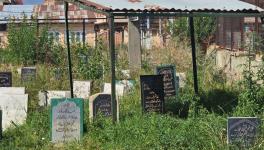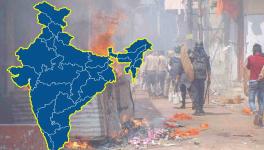Sunny Side up: How Solar Power is Sparking Job Revival in Kashmir
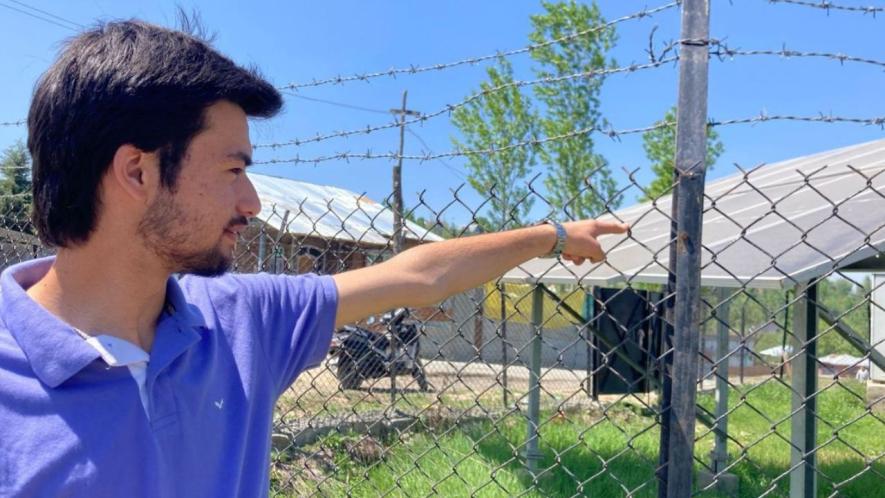
Shakir pointing towards solar panels (Photo - Arsalan Bukhari, 101Reporters)
Baramulla: “I did not go looking for a job, I created one,” said Mudassir Ahmad Bhat (32), seated in his guesthouse in Sawan village in Baramulla district of northern Kashmir.
Outside, the guesthouse blends into Kashmir’s quiet beauty — dark wooden frames nestled along narrow lanes lined with wildflowers and tall pine trees. The air is crisp, scented with damp earth and the cool mountain breeze. Until a few years ago, these lanes would fall silent each winter, as men left in search of work.
“From 2010 to 2024, nearly 70% of the men in our village would migrate to cities across India, selling Kashmiri handicrafts from Maharashtra to Uttar Pradesh,” Bhat told 101Reporters.
The region’s harsh winters, unreliable power supply and lack of local jobs left them with little choice.
“I still remember when electricity was a distant dream for us,” he added. “Now, we have solar power and things have changed for the better.”
Bhat, a postgraduate from Kashmir University said that he was looking for ways to earn a sustainable income without leaving home.
“There are only government jobs here which have very few vacancies. Even for Class IV posts, PhD holders were applying… Till last year, I would travel 365 days, away from home, selling shawls in Uttarakhand,” he said.
When my family heard that the Jammu and Kashmir Tourism Department was registering village homes as accommodations, we took a risk – pooling around Rs 8-10 lakhs, most of our savings to build a guesthouse, Bhat added.
Their very first guest left within hours due to a power cut which used to last six to eight hours in 2022. With no light, no hot water and no backup the newly-built homestay struggled.
“I told my father let us just shut it down,” Bhat said.
But then there came a ray of sunshine, literally.
Powered by the sun
In March 2024, the Jammu & Kashmir Power Development Department informed residents of Sawan and other villages about the Prime Minister Surya Ghar Muft Bijli Yojana, a central government scheme aimed at expanding access to rooftop solar power. Several families, including Bhat's, signed up immediately. More than 100 individuals are enrolled in this area by itself.
The scheme subsidises solar panel installations for households, with both central and Union Territory-level financial support
A basic 1 kW rooftop system, priced at Rs 55,000, comes with a Rs 3,000 subsidy from the Union Territory and Rs 33,000 from the central government, reducing the cost to Rs 19,000.
According to the latest price list shared by the electricity department, a 2 kW solar system costs Rs 1,11,000, of which Rs 72,000 is covered through subsidies from the central and Jammu & Kashmir governments, bringing the user’s share down to Rs 39,000.
A 5 kW system is priced at Rs 2,58,500 and comes with a total subsidy of Rs 94,800, again split between the two governments. The highest capacity option, a 10 kW system, costs Rs 5,06,000 and also receives Rs 94,800 subsidy.
In most inverter models, except for one or two, the Jammu & Kashmir UT offers a fixed subsidy of Rs 9,000, while the central government covers the larger portion.
Bhat’s guesthouse went from four rooms booked to seven on an average. Monthly revenue shot up from Rs 12,000 to nearly Rs 40,000.
“Since we installed solar panels, guests don’t complain,” said Nadeem Ahmed (33) who also runs a guesthouse in Sawan.
Ahmad has installed a 5kW solar inverter that cost Rs 2,58,500. After a combined subsidy of Rs 94,800 from the J&K Union Territory and Ministry of New and Renewable Energy, he now only has to pay Rs 1,63,700, on Equated Monthly Installments (EMIs) spread over three to five years.
“With a proper electricity supply, we were able to start generating revenue of Rs 1 to 2 lakh per month within a couple of months,” Bhat’s father Farooq Bhat (65) said. “In about three months, we had recovered our investment.”
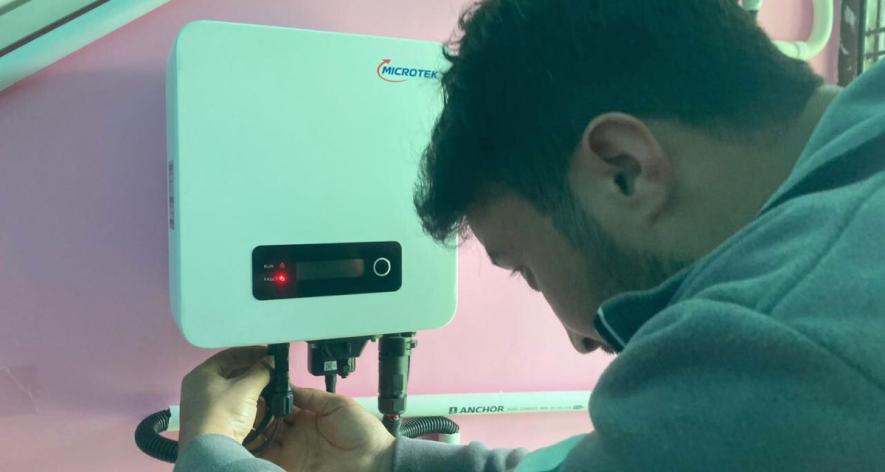
Installing equipment in the house (Photo - Arsalan Bukhari, 101Reporters)
Before the sunlight
In 2023, Ahmad returned from Saudi Arabia, where he worked in a billing store connected to Aramco. “I used to work 10-hour shifts in harsh conditions for little money. I couldn’t take it anymore. My father, a retired cab driver, was too old to work. I had two daughters and no income,” he says.
Ahmad came back to Kashmir and said he “couldn’t see myself giving horse rides to tourists in Gulmarg like some of my neighbors, after all, I’m a graduate.”
He also turned his home into a guesthouse, but constant electricity outages nearly sank the business. “We had power cuts for two to four days at a time. At first, I earned Rs 20,000 a month. Then it dropped drastically. Tourists stopped coming back. Some foreigners who loved the villagestays vanished too.”
“I considered buying a commercial generator, but it would have cost Rs 5 lakh.” he added.
Farooq said, when power cuts started thinning the guest list, the family began renting diesel generators at Rs 1,000 a day, excluding the cost of fuel. But the costs quickly spiraled out of control. They had to raise room rates, making them nearly as expensive as hotels in Srinagar.
And that, said Bhat, defeated the point. “People don’t come to these village guesthouses for luxury, they come here to form connections.”
“Guests often tell us: We want to see how people in heaven live and eat…Kashmir is beautiful, yes, but what touches them most is the way we host them,” Bhat added.
“We serve them the food we eat ourselves, the noon chai we drink. They sit with us. They ask about our lives.” These guesthouses, he said, make Kashmir more accessible.
“Many of our guests come from modest backgrounds. They can’t afford luxury hotels. But they can afford to stay with us.”
But, frequent power cuts and rising fuel costs meant they had to charge more, quietly eroding the warm connection with guests.
According to Renewable Energy Engineer And Resarcher Sajjad Ahmed Shah in Srinagar, “The Kashmir Valley has 13 hydroelectric power projects that can easily meet our local demand,” Shah explained. “But they’re controlled by the central government’s NHPC (National Hydroelectric Power Corporation). The electricity produced here is sold to other states to generate revenue and little reaches the residents here.”
A new dawn
But, the decentralized solar revolution is quietly transforming village life in Kashmir. In just six months, the number of registered guesthouses in the region has increased from barely a dozen to over 300, according to Fayaz Ahmed, a tourism official with the J&K government.
For many families, this shift means they no longer have to migrate in search of work. “At least four or five families in our village have stopped seasonal migration,” said Ahmad. “Six to eight new guesthouses are coming up around us, that’s never happened before.”
This energy transition is also creating new opportunities for women. Shaheena Akhtar (51) a single mother, recalled how limited things were earlier: “All we had was collecting wood in the jungles and making charcoal. That wasn’t enough to feed a family.”
After the solar push in August 2024, Akhtar registered her home as a guesthouse and installed a 3kW rooftop solar system. “I’m still learning, but I now earn Rs 15,000 to Rs 18,000 a month.I had no source of income earlier,” she said. “I used to be invisible, even to my own relatives in Srinagar. Now, they call me to book rooms for their friends. Solar power has lit up my life.”
“My dream is to send my daughter to become a pilot. For the first time, that dream feels possible,” Akhtar said, adding, “Tourists love the natural beauty, but they used to avoid places with unreliable electricity or noisy diesel generators.”
The shift to solar has changed that. Homestays now offer cleaner, quieter, and more affordable options, some as low as Rs 1,500–2,000 a night.
For local entrepreneurs, especially in areas like Tangmarg, solar electricity has kept the lights on and opened doors to stable income in a region where jobs have long been scarce.
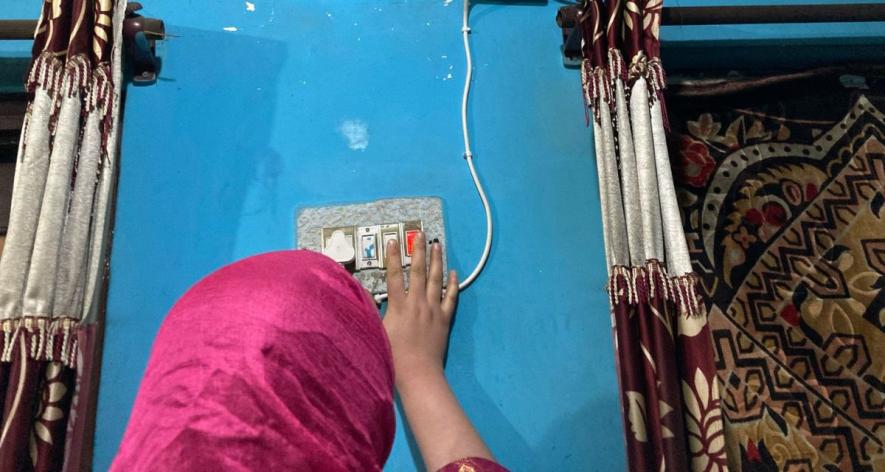
Blindspots in the solar scheme (Photo - Arsalan Bukhari, 101Reporters)
Blindspots in the plan
While the solar scheme has spurred economic activity in Kashmir’s remote villages, it remains an imperfect fit for many.
Mohammad Aslam (62), who runs a guesthouse in Sawan village, said that despite subsidies, the upfront cost is still too high for small business owners. “For winter, even 1-2kW won’t suffice. I need at least 5kW, which means paying Rs 1.6 lakh even after subsidy. An 8kW setup would cost around ₹3 lakh — that’s just not feasible,” he said.
Guesthouse owner Shakeel Mir, also from Sawan, added that solar isn’t always reliable. “In the rainy season and winter months, we barely see any sunlight. The inverter backup lasts 3-4 days, which helps, but power remains a challenge during those times.”
Aslam also flagged hidden costs. “The power department gives the inverter and sends one or two technicians, but we have to arrange extra local labour for the installation. In winter, when snow falls on the panels, we have to clean them ourselves.”
He believes the initiative is well-intentioned but incomplete. “They just install the panels and leave. Our sloping tin roofs become death traps in winter, one slip while wiping snow and you’re gone. No one talks about upkeep, after-sale support, or how risky this is. Solar sounds good in theory, but in practice, it puts us at more risk during winters.”
For the scheme to truly work, he added, “It must go beyond just installing panels. We need affordable solutions for larger energy needs, regular maintenance, and better support systems.”
Arsalan Bukhari is a freelance journalist and a member of 101Reporters, a pan-India network of grassroots reporters.
Get the latest reports & analysis with people's perspective on Protests, movements & deep analytical videos, discussions of the current affairs in your Telegram app. Subscribe to NewsClick's Telegram channel & get Real-Time updates on stories, as they get published on our website.









